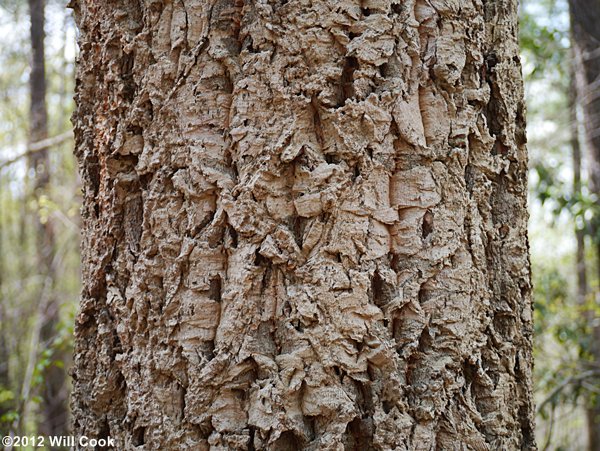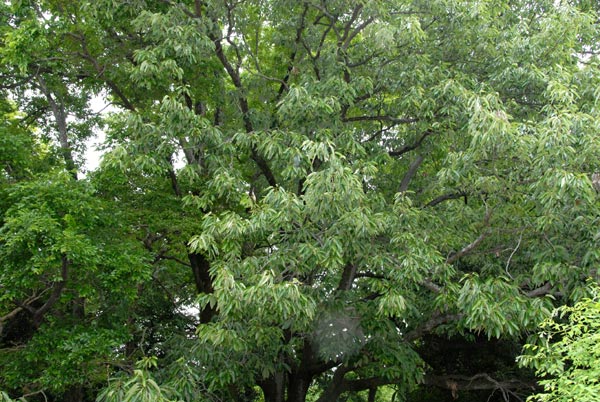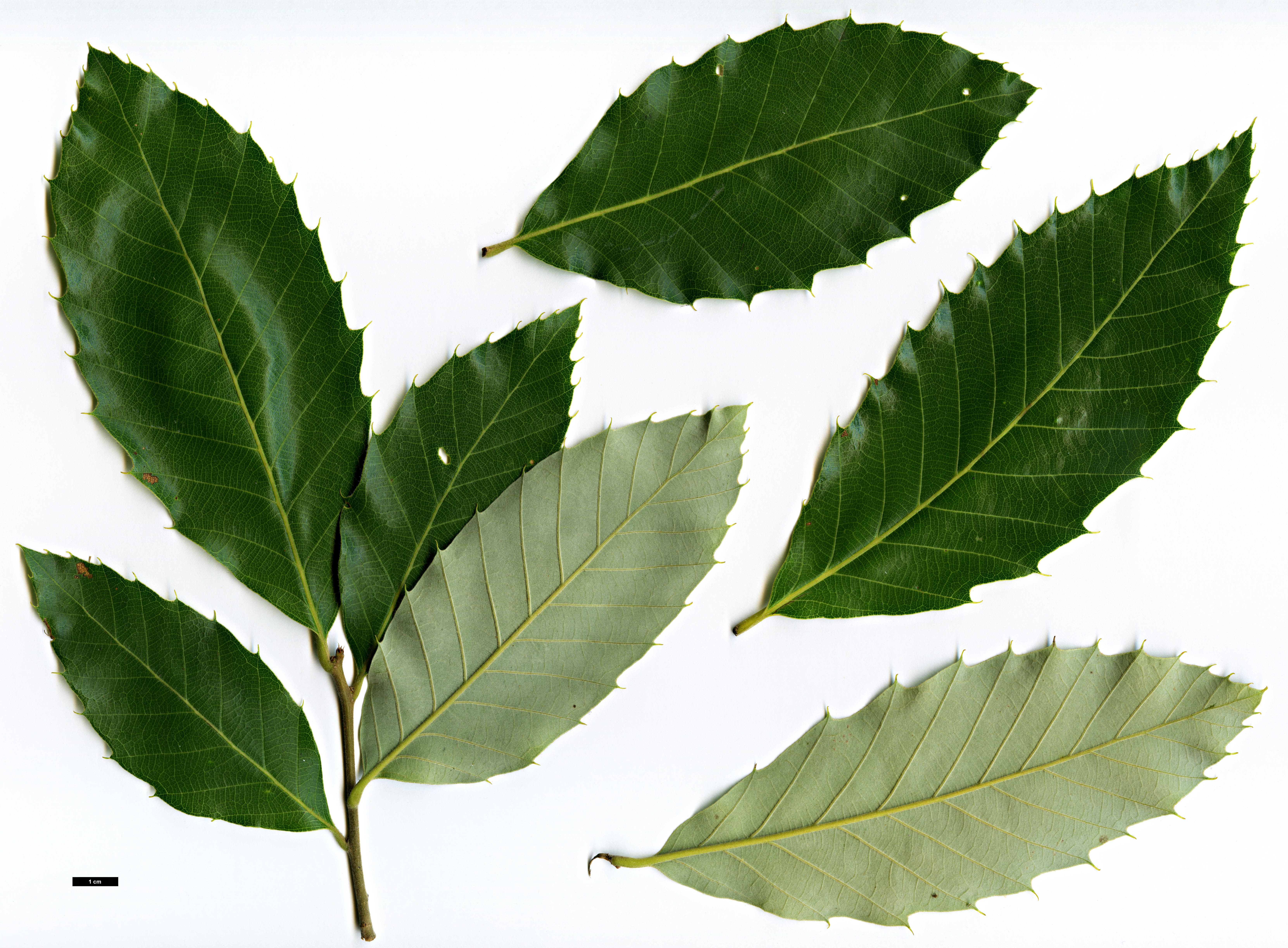Quercus variabilis
Chinese Cork Oak (Quercus variabilis )
The Chinese Cork Oak (Quercus variabilis ) is a deciduous tree of the genus of oaks. It is in the southeast of China is an important forest tree of medium size, in Europe but little known. The name Chinese cork oak it deserves due to the thick layers of cork, which makes them similar to the cork oak. The cork is harvested at regular intervals. Remarkable are the leaves, which resemble those of the chestnuts and the almost round acorns are hidden two-thirds of the fruit cups.
Description
The Chinese cork oak tree is a deciduous tree of the stature heights up to 45 meters in height and trunk diameter (BHD ) reaches 1 meter. The average height is 18 feet with trunk diameters of 20-33 centimeters. The crown is broad and rounded, and is made of strong branches.
The deeply furrowed bark is gray-brown to blackish and is 2 to 5 inches thick. Mature trees form a dark brown cork layer, which is used commercially. The wood has a yellowish-brown sapwood and reddish brown core. It is ring porous and straight grained. The Chinese Cork Oak is a strong, deep reaching tap root system that can reach a depth of 1 meter for a year. The roots of older trees come down to a depth ago 6-7 meters. The lateral roots are 6 to 7 feet long and grow very densely in the upper soil layers.
The winter buds are yellowish brown and 3 to 5 millimeters long. The leaves are alternate and are 8-20 inches long and 2-5 inches wide. You are not lobed, have an elongated elliptical shape and a slightly crenate serrate margin. So that they resemble the leaves of the chestnut. There shall be 9 to 18 pairs of leaf veins which terminate in short projecting over the edge of the sheet bristles. The petioles are 1-5 inches long and bare. The upper leaf surface is dark green, the lower leaf surface appears gray-white through the dense star hair.
The Chinese Cork Oak is monoecious getrenntgeschlechtig. The male flowers grow in 14 inch long catkins, covered with short yellow-brown hair. They have five stamens, the perianth is five to sechszipfelig and leathery. The female flowers appear singly in the leaf axils and also form a five to six-part perianth and three pen. Rarely do we see back- formed stamens.
The acorns are broadly ovate, and have a diameter of 2.5 to 4 centimeters and a maximum of 1.5 to 2.7 inches long. They are enclosed two-thirds of the fruit cups. The fruit cup is covered by numerous, rolled up, overlapping, pointed scales.
The Chinese Oak blooms from March to April, the acorns mature in October and September.
Distribution and habitat requirements
The Chinese cork oak flourishes in hilly and mountainous areas of warm temperate and subtropical zones in the south-eastern China. The center of the range is West Hubei, the Qin Ling Mountains and the Dabie Shan mountain range. They are also found in Korea, Japan and Taiwan. It grows at altitudes between 10 and almost 2500 meters. The mean annual temperatures in the natural range are 12-16 ° C, cooling down to -18 ° C will endure. The annual rainfall ranges 500-1600 mm. It needs plenty of light and is sensitive to shading. Through the cork layer and the very deep root system it is insensitive to drought, storms and drought. The species grows on both acidic to slightly alkaline soils with pH values of 4 to 8 are particularly favorable nutrient-rich, well- drained soils of loam or sandy loam.
Ecology
The Chinese cork goes with the chanterelle ( Cantharellus cibarius ) a mycorrhizal symbiosis.
The acorns are infested by the weevil Curculio davidi, young plants are damaged by several rodents, so from the Pere David Red Squirrel ( Sciurotamias davidianus ) from the kind of Chinese red squirrels and the long-tailed hamster ( Cricetulus longicaudatus ) from the kind of gray hamster. The cork can be infected by the fungus Truncopora truncatospora, the leaves by the rust fungus Cronartium quercuum, the wood from rot -causing Lackporlingen lobatum Ganoderma and Ganoderma lucidum.
System
The Chinese cork oak belongs to the section of the oaks in the kind of the oaks. It can be crossed with the cork oak, the resulting offspring are frost harder than both parents ( heterosis ).
Use
The economically most important use is the extraction of the cork. It has a low density of 150 to 300 kg/m3, and has a high elasticity. It is water repellent, resistant to acids and bases, sound insulation and corrosion resistant. The cork is further processed into insulation blankets used in the electrical industry, mechanical engineering and for packaging. To Korknutzung to trees with trunk diameters are 13 to 15 centimeters, which can be reached from the age of 15 to 20 years. Korkernten be performed approximately every 10 years, when the cork layer has reached a thickness of 1.5 to 2 centimeters.
The acorns are used because of their high content of carbohydrates as nutritious animal feed. The wood is used as construction wood, but also used in shipbuilding and in the art joinery.








